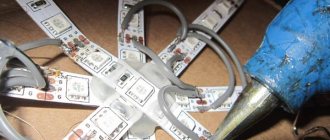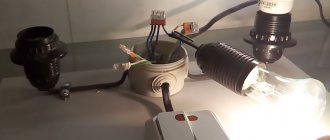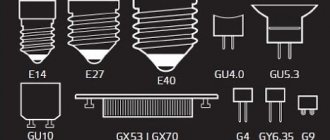LED lamps - device features
LED light bulbs are very popular and in demand; they are gradually replacing similar devices with incandescent filament from the market. Despite the significant cost, many apartment owners strive to purchase diode lamps, since they have a significantly longer service life, efficiency and reliability.
Compared to incandescent lamps, the design of diode devices is somewhat more complex. Let us highlight the main elements and describe their purpose:
- The base is made of brass and plated with nickel, which prevents corrosion and promotes reliable contact with the cartridge.
- The polymer base of the base part is coated with polyethylene terephthalate to protect the device body from electric shock.
- Driver – is implemented according to the circuit of a galvanically isolated modulator of an electric current stabilizer. The main purpose of the driver is to ensure stable, uninterrupted operation even during network voltage fluctuations.
- Radiator – made of anodized aluminum alloy. Required for effective removal of thermal energy from the remaining elements of the light bulb.
- A printed circuit board made of aluminum on a heat-conducting mass guarantees the required operating temperature of the chips by removing heat to the radiator directly from the chips.
- Chips - in fact, this is the lighting mechanism, in other words - diodes.
- The diffuser is a glass hemisphere, the level of light dispersion of which tends to the maximum.
LED lamp device
The principle of operation of LED lamps for the common man is quite complex and confusing. In short, glow occurs as a result of the release of photons due to the constant change and recombination of electrons, followed by a transition to other energy layers. The uninterrupted flow of the process is ensured by the semiconductor materials of the chips. To ensure optimal operating conditions for the entire device, various resistors or current-limiting mechanisms are used.
Some manufacturers today are trying to introduce improved technologies for creating a glow, in particular, using special diode bridges. The cost of such light bulbs is slightly higher compared to other LEDs, but the quality fully corresponds to the price.
The main causes of air jams
If air pockets occur, check the tightness of the connections.
The appearance of bubbles in the water supply lines is associated with an internal physical and chemical reaction or penetration from the outside. In the first case, gas escapes from the water flow itself, because approximately 30 grams of air are dissolved in 1000 liters of water. The release of a gaseous substance occurs faster if the liquid flows slowly and if it is heated. It is for this reason that voids and cavities occur much more often in hot water pipes. In the second case, air from the external environment leaks into the main networks.
The main reasons for the appearance of air from outside in the water supply system of a private home:
- when the liquid level decreases, air can be sucked in through the non-return valve;
- the fitting elements with rubber sealing parts are poorly covered, depressurization occurs at the joints;
- the air in the water supply lines was not removed from the first start-up of the system.
In vertically directed pipes, air rises upward or is absorbed throughout the cavity. In horizontal ones, it accumulates in the highest places, which is unfavorable for the entire system.
Because of the switch, when the light is off, the LED light glows
Currently, a huge number of electrical devices that have long been known and familiar to everyone are equipped, for ease of use or control, with additional elements that cannot work correctly together in one electrical circuit.
These devices include a switch in which an LED is installed for convenience. In this case, normal operation of such a switch and LEDs is impossible. Therefore, some work is required.
Troubleshooting work:
- Switch modification;
- Replacing the switch.
As mentioned earlier, the LED installed in the switch is connected to the network through a resistor for optimal operation. In turn, the resistor, constantly giving off the accumulated charge to the LEDs, makes them glow.
Therefore, in this situation, the best solution would be to remove the LED from the switch circuit. This is done quite simply. The switch is disassembled and, using wire cutters, the LED and resistor are bitten off.
The best solution to get rid of this problem is to remove the LED from the switch circuit
It is worth noting that if you have a regular switch, you can use the second method. Just replace it.
Note! Carry out all electrical installation work only when the mains voltage is turned off.
To do this, you need to turn off the circuit breaker in the distribution panel. After this, using a set of screwdrivers, disassemble the switch, disconnect it from the live conductors and install a new one.
Useful tips
When performing repair work on an electrical circuit, it is important to follow a few tips. Let's highlight the main ones:
Let's highlight the main ones:
Let's highlight the main ones:
- Always check the voltage level before carrying out repairs.
- If possible, call a specialist for electrical repairs.
- Install high quality machines. This requirement also applies to wires, sockets and switches.
- For safety, use cotton tape (it provides better insulation).
- The appearance of visual damage or thinning of the metal indicates the need to replace the socket.
Please note that electricity is deadly and should not be trifled with. If any problems arise with the outlet, junction box or input panel, it is better to fix the problem immediately.
Delaying repairs often leads to aggravation of the situation, damage to household appliances and even a fire.
Additionally, working on an electrical circuit without the proper knowledge may result in exposure to voltage, serious internal injury, or death.
Lamp glow when the load is off
There are several likely factors that could explain why the lighting element is still lit after being disconnected from the power source, albeit dimly:
- Problems with electrical wiring, in particular, poor-quality insulation on one of the sections of the circuit.
- The LED lamp is connected to a backlit switch.
- Poor quality emitters used in the design of the light source.
- Functional features of the lamp.
If the emitters burn when the switching device is in the off position, it is recommended to first consider all other factors except the first, since it is problematic to determine the area of hidden wiring that is weak in insulation.
To do this, conditions are created under which a circuit breakdown occurs (high voltage is applied for 1 minute). The problem area, due to which the diode lamps glow after the load is turned off, will have to be opened: the integrity of the wall is compromised if the wiring is laid using the gating method.
A very common situation occurs when energy-saving light sources function differently when connected to a backlit switching device. The problem here lies in the fact that the lighting element installed in the switch completes the circuit, which means it passes a small current. It powers the diode lamps when the lights are off.
The problem of cheap LED products is no less common. If a product of low quality at an affordable price was chosen, and usually the connection between these factors is direct, then there is a high probability of an error in the soldering board. But it happens that the emitter, although dimly, burns due to the functional features of the design.
In particular, we are talking about the processes that occur in the resistor when a load is applied to the lamp: this element accumulates energy as current flows through the circuit, and after the load is turned off, it maintains the glow in the emitters.
Poor quality wiring
Another common reason why LED bulbs light up when the switch is off is faulty wiring. You should seriously think about repairing it if:
- aluminum wires have been in use for more than 30 years;
- problems arise with LED lamps from different manufacturers;
- the switch that opens the circuit with the LED lamp does not have a built-in backlight.
Electrical wiring can affect the operation of an LED lamp in two cases:
- The phase and zero are swapped, that is, the phase wire goes directly to the cartridge, and the zero wire goes directly to the switch. In this case, the LED spotlight driver or bulbs are constantly energized, causing the LEDs to either dim or flash despite the electrical circuit being open. The problem is solved by reconnecting the wires in the junction box so that the “phase” goes to the switch, and the “zero” goes to the lamp.
- Another malfunction is a violation of the integrity of the hidden wiring, or rather the insulation of one of the wires. As a result, a small leak occurs inside the reinforced concrete wall, and the LED lamp continues to glow after the light is turned off. Using a megohmmeter, you can measure the insulation resistance and make sure that its value is underestimated. But it will not be possible to determine the location of the breakdown. Therefore, there is only one way out - to replace the section of wiring from the junction box to the chandelier.
LED lamps glow after switching off: troubleshooting
If the reason for the glow of LED lamps is a backlit switch, then in this case you can do without altering or replacing it. To do this you need to do the following.
In order to troubleshoot the problem you must:
- Select a capacitor;
- Integrate a capacitor into an electrical circuit.
First of all, an additional element in the form of a capacitor is selected. This circuit is known to many, but when designing it, one mistake is made, which leads to the failure of the capacitor.
This is an incorrect device selection based on voltage. It is known that a current with a voltage of 220 Volts is used for the public network. This indicates that this voltage is active.
Note! The value of the effective voltage is equal to the maximum voltage (amplitude) divided by the root of two.
This suggests that when a maximum voltage value occurs in the network, the capacitor may not withstand the load and fail. Therefore, to install capacitors in a 220 Volt circuit, it is best to use capacitors with a rated voltage of 630 Volts and a capacitance of 0.1 µF.
If the reason for the glow of LED lamps is a backlit switch, then in this case you can do without altering or replacing it
Once the correct capacitor has been selected, you can begin installing it. To do this, you need to solder two wires about 5 cm long to its contact legs. Next, the device is mounted in the circuit. Installation is carried out in parallel. Polarity is not required.
Mount the capacitor in the junction box, to the wires going to the lighting device, or to the contacts of the cartridge.
Why the light in the apartment blinks: searching for causes and solutions
Instability of the power supply often leads to the fact that the light begins to flicker.
This phenomenon not only causes inconvenience to residents, but can also cause damage to electrical appliances.
If you detect a blinking light in an apartment, you need to quickly identify the breakdown and fix it.
Why the lights blink in the apartment: causes of problems and solutions
A reliable electrical network is the key to stable and safe operation of devices. If a problem is detected with the electrical network, you should identify the problem and solve it in the shortest possible time.
When the light in an apartment blinks, there can be various reasons - from current surges to a malfunction of the light bulb itself. The most common causes associated with flickering lights include the following:
- accidents at the substation;
- damage to an electrical appliance;
- light bulb breakage;
- the socket/group of sockets is faulty;
- loose contact in the junction box;
- incorrectly selected operating mode of the device;
- damage to equipment in the panel;
- wear and tear of cables;
- connecting powerful devices to a network not designed for such a load.
If a flickering light was detected in one of the rooms, you need to check the functioning of the remaining lamps in the apartment and other devices. If the operation of other electrical appliances is unstable, as well as periodic power outages, the problem must be looked for in the network.
Flickering of a lamp connected to a socket
A flickering lighting fixture should be plugged into a working outlet. If it works, you need to repair the outlet it was originally plugged into.
What to do for repair - first of all, you need to turn off the voltage on the line. Then you need to unscrew the screws that hold the socket in the box. Need to look at the parts. If everything visually looks normal, the screws are tightened and reliable contact is created. Then voltage is applied and the device is connected. If performance is unsatisfactory, the socket is replaced with a new one.
Other reasons
One of the reasons for the blinking light is a breakdown of a powerful device or poor contact of the device connected to the outlet with the network. An energy-intensive device can partially penetrate the grounded frame, but still work. With such a hidden problem, the voltage becomes unstable and the lights blink.
If the lamp blinks at a frequency of 100 Hz, which is noticeable with peripheral vision, the problem is in the semiconductor diode through which it is connected. The diode needs to be replaced. Such blinking is safe for the electrical network, but causes discomfort for vision.
The lights in the house may flicker due to the connection of the welding machine. The solution is to purchase a powerful stabilizer and replace incandescent lamps with high-quality LED or fluorescent ones.
If the apartment is equipped with LED lamps, voltage surges will be unnoticeable, since high-quality devices operate stably both with high and low power. Why does the light blink even in an LED lamp? The problem is in the device itself. The power supply may contain a capacitor of the wrong capacity. In this case, you should replace the light bulb with a reliable, proven analogue.
Main conclusions
A stable electrical network in the apartment is an important condition for the reliable and safe operation of household appliances. If the light blinks, this indicates problems with the lamp or electrical wiring. If the light blinks, this indicates problems with the lamp or electrical wiring.
If the light blinks, this indicates problems with the lamp or electrical wiring.
Before you start repairing yourself or calling an electrician, you should understand why the lights in the apartment are blinking.
The more data the resident of the house collects and presents to the repairman, the faster the repair will be made.
It is prohibited to carry out repair work independently without the necessary skills and abilities. Also, you should not repair wiring with low-quality, uninsulated tools. Failure to comply with safety precautions may result in electric shock.
Why does the lamp glow or blink?
One of the most common reasons is the backlight on the switch. LEDs are sensitive to ultra-low currents and interference, and the backlit switch elements allow weak currents to pass through, even when the state is “off”. The second, also very common reason, is that the switch opens zero instead of phase. A broken zero, as a rule, has a capacitive coupling with the surrounding wiring and due to this, parasitic currents arise.
The situation when the switch breaks zero is ubiquitous in Soviet-era wiring. This phenomenon is so common that sometimes it seems as if it was done on purpose. Let me remind you that in the “correct” electrical wiring, the switch must break the phase. A broken zero, by the way, causes the indicator screwdriver attached to it to light up. Similar to an indicator screwdriver, a light bulb sometimes only needs a fraction of a milliamp to produce a faint glow.
Why do some lamps glow dimly and others flicker? This is usually due to the design of the lamp driver, which is hidden in the base. It is believed that a flashing lamp has a better driver, while a smoldering lamp has a cheaper driver. It’s difficult to say about reliability here; both burn out.
Glass polishing
Experts recommend periodically polishing polycarbonate lamps to maintain their impeccable appearance. But this procedure should be approached wisely so as not to add damage to the surface.
What is necessary
For high-quality polishing of lighting fixtures you will need the following consumables:
- a couple of buckets of purified water;
- paste intended for polishing lampshades. It comes in two types - abrasive and non-abrasive. Both types will be useful;
- a pair of microfiber cloths;
- several types of sandpaper, the grain size of which will be in the range of 800–2500 units;
- adhesive tape.
Also, when polishing, you cannot do without some tools:
- polishing machines. Many people don’t have a special unit, and the purchase will cost a pretty penny. Therefore, for polishing you can use a drill to which an attachment with a polishing wheel is attached;
- two polishing wheels of different hardness. One of them should be hard, white or orange, and the second should be soft, black;
- a spray bottle from which you will spray clean water onto the circles.
We paste over
First of all, wash the headlight. There should be no grains of sand left on it. After washing, the lamp should be allowed to dry. You can spend this time covering the perimeter of the ceiling with tape. This is necessary so that if the sandpaper slips, the painted body parts adjacent to the lamp will not be scratched.
Cleaning up
Then we start cleaning. We take sandpaper with the coarsest grit we have and begin to rub the surface with it. Coarse-grain paper effectively removes chips and scratches.
Next, when rubbing, we gradually change the paper to a more grainy one. This material will eliminate traces of work.
When working with paper, do not forget to periodically wet its surface, as polycarbonate particles can quickly clog it.
When stripping, it is recommended to make circular movements, as well as move your hand crosswise.
Don't be alarmed if the plastic becomes even cloudier after grouting. The main thing is that the old chips and scratches no longer remain on it.
Polishing with a machine
First, attach a hard polishing pad that is yellow or white in color. A little abrasive paste is applied to it. We begin to polish the plastic until it is no longer matte.
We must not forget that friction causes objects to heat up. Make sure that the polycarbonate does not begin to melt as a result of prolonged polishing. Since the stain formed due to exposure to high temperatures cannot be removed.
After finishing polishing, wipe the surface with a dry microfiber cloth.
Next, we attach a softer polishing wheel, which is black, to the machine or drill. Apply a little non-abrasive paste to it. It will hide traces of the work carried out and give the lamps a glossy sparkle.
Polish until the entire headlight is evenly shiny.
After this, the transparent surface must be washed with clean water.
Glass
It is worth noting that glass headlights can be polished in approximately the same way, but you need to remember some nuances:
- You should not start polishing if there are deep chips or scratches on the headlight. You can cut yourself on their edges or damage polishing wheels and cloths. Glass surfaces with major damage are first filled with a special colorless polymer, which is dried under ultraviolet lamps, and then polished with an abrasive paste.
- The glass headlight needs to be watered more often during the polishing process.
The lamp lights up after turning off - solutions to the problem
Having decided why the LED light is on when the light is off, you can move on to solving the problem. The following is a list of basic recommendations, depending on the causes of this phenomenon. If dim light is associated with purchasing a product at an affordable price, but of low quality, then the advice here is very simple - you need to go to the nearest store and buy a high-quality light bulb from a reliable manufacturer.
If the problem is the backlight in the switch, there may be several solutions. You can act logically and, following the example of the first point, go to the store for a switching device that does not have backlighting. Another option is to cut off the power wire that controls the backlight. To do this, you will need to open the switch, which is done quite simply and quickly; even beginners in this matter will be able to disassemble and reassemble the device on their own in a few minutes. If you cannot do without backlighting, then you can just install another resistor in the circuit, which will prevent the accumulation of energy.
The main thing is to find the cause of this glow, after which you can begin to take action.
Isolation, as noted earlier, causes the greatest difficulties in solving the problem. If you do not want to violate the integrity of the wall, then you can try to go the other way. Its essence is to connect an additional load (relay, resistor, incandescent lamp) in parallel with diodes that do not stop burning. The only condition is that the resistance of the connected additional device must be less than that of the LED lamp. Due to the weak resistance, the connected element will not light up, and due to the redirection of current, the LED lamps will also not light up after turning off.
So, we told you why LED bulbs light up when the switch is off, and also that solving such a problem is not so difficult. The main thing is to find the cause of this glow, after which you can begin to take action.
LED operating principle
As a type of device that uses the photoelectric effect, an LED is a semiconductor device, the sensitive panel of which, when a certain voltage is applied (up to 12 V inclusive), begins to emit a powerful luminous flux.
This is the LED lamp design
The LED circuit diagram includes:
- A rectifier, most often assembled using a bridge circuit. Its purpose is to convert the original 220 V alternating voltage in a household electrical network into direct voltage.
- A light regulator (dimmer) is a unit that is responsible for gradually adjusting the brightness of a light bulb.
- Capacitor - smoothes out peak voltage fluctuations that are inevitable with any rectification circuit.
- Actually the LED, which emits the luminous flux with the power declared by the manufacturer.
- Switch (often backlit).
Excluding the connectors, housing and other mechanical components of the LED lamp, it is the above components that can cause the lamp to blink when the light is off and the switch is tripped. This irritates others, can make the room feel uncomfortable, and frequent blinking worsens your health, can cause headaches, etc.
To understand the problem, consider the above blocks sequentially.
Rectifier
Produces half-wave or full-wave (depending on the manufacturer) rectification of alternating current, while the lamp blinking frequency can range from 20 to 30 Hz. Build quality also matters, since dirty contacts oxidize faster. LED lamps from higher-rated brands (in particular Phillips or Osram) are equipped with higher quality rectifier diode bridges, so the frequency with which such lamps blink is much higher - up to 50...60 Hz, and therefore is not perceived by you.
Thus, due to the normal functioning of the rectifier, when the light is turned off and the switch is tripped, all LED lamps should blink, it’s just that in some cases the eye senses this, and in others it does not.
Dimmer
The node that is responsible for maintaining the RGB mode of the LED light bulb. The presence of a dimmer is convenient from the point of view of creating the required spectral composition of lighting in the room - “warm”, “normal” or “cold”. The RGB controller itself is not capable of causing flickering of an LED light bulb that has already been turned off by the switch, but the remote control unit that comes with it is no longer so blameless: for example, if the battery inserted into the remote control has already exhausted its resource, then the voltage of the control signal becomes much lower, and you need to press the switch button you have to press several times.
The problem is that the voltage applied to the dimmer is applied according to the well-known physical principle of superposition, which will lead to the blinking of the light bulb after it is turned off. However, just in case, it’s worth cleaning the remote control from dirt, especially the switch button; it won't create a problem.
Using the glow for good
Let me make a reservation right away: only “smoldering” lamps will do; it’s unlikely that it will work with blinking ones. I personally witnessed the long operation of lamps in this mode, but I do not rule out that these experiments can significantly shorten the life of the lamps. There are too many different lamp designs and not enough data to make clear conclusions.
So, a weak glow can be used as a feature, an additional lighting option. A night light in the corridor, a romantic twilight in the room - “smoldering” can be used effectively. The main thing is to learn how to properly control this glow.
Good results will be achieved by proper “correct” wiring and switches without backlights. That is, when the lamp is turned off, it does not glow at all.
The same capacitor, but connected in parallel with the switch, can make it glow. Also, capacitors of 0.047-0.1 µF for 400-600 volts are suitable. Here you may have to select a container for the desired glow. For convenience, you can use a two-key switch instead of a single-key switch: the first key must be connected according to the standard circuit, and the second through a selected capacitor. You will get two modes - normal and night light!
If the lamp glows initially, you can try connecting a capacitor in parallel with the lamp to eliminate it, and another capacitor, but of a larger capacity, to the second switch key. In general, you will have to experiment. But overall, I think this idea is quite interesting.
In all my experiments with the “night light” I used non-dimmable lamps. The photo below shows two types of cheap lamps that “smolder”.
If replacing the plugs doesn't help
If, after replacing the plugs or turning on the machines, electricity still does not appear in your home, you will have to call an electrician to diagnose and eliminate the causes of the loss of power at home. You can carry out this work yourself only if you have certain knowledge and skills, since incorrectly installed wiring can short out and cause a fire. Moreover, electric shock if you do not know and follow safety rules can lead to fatal consequences.
Re: Power outage, machine won't turn off
Somewhere the contact is lost. You need to start with the electrical panel (floor panel) and then through all the distribution boxes that are located in the apartment
Pay attention to burning of insulation, color of connection contacts, charring of insulation
All thematic questions and answers to them, only on the forum! I don’t answer personal messages for electricians.
Menin Thread starter
How to solve the problem of dim light
Recommendations may vary depending on the size of the problem:
- If you initially purchased a cheap LED lamp, then it is possible to eliminate the glow only by installing a product from a reliable manufacturer and of high quality.
- When the problem lies in the backlit switch, it can be eliminated in different ways. The simplest solution is to change the switching device to a model without backlight. You can also cut off the corresponding backlight power wire; this is done after opening the switch. But in some cases it is important to preserve this function. Then you need to install a resistor in parallel on the desired section of the circuit.
- The hardest problem to fix is the one in the wiring. To do everything correctly, of course, it is recommended to find the source of the leakage current. But, as already mentioned, this will entail other difficulties. But as a result, when the light is turned off, the diode lamps will not light up. But you can go another way, a simpler one. To do this, a load (incandescent lamp, resistor or relay) is connected in parallel with the diodes that light up. It is important that the resistance of this element is less than that of LED emitters. As a result, the leakage current will flow, for example, to an incandescent lamp. But due to the slight resistance it will not burn.
As you can see, there are many ways to solve the problem of diode-based emitters, which, although dim, still shine when turned off. It is necessary, if possible, to determine the most likely cause of this phenomenon.
Which boiler elements depend on electricity?
Power outages to houses not only in the outback, but also in cities occur quite often.
They happen due to emergencies, planned repairs and technical work, and breakdowns on the line. And the most unpleasant thing is that when the electricity is turned off, the operation of the gas boiler is paralyzed if it is of the volatile type. The non-volatile gas boiler continues to function as usual, even if there is a power outage on the power line. The only exception is if a pump works in conjunction with it, and a gravitational coolant circulation system is not provided.
Non-volatile boilers have the simplest, basic set of functions. They are less comfortable to use than their energy-dependent counterparts. But their operation is absolutely independent of energy supplies to the home electrical network, and they are less likely to fail
In a heating circuit with a boiler of the simplest type, the set of basic elements is something like this:
- smoke removal system with natural draft;
- heat exchanger;
- gas burner with nozzles for supplying gas, which is located in the combustion chamber;
- gas supply and ignition unit;
- expansion tank;
- mechanical temperature sensor;
- control module, which includes a boiler ignition system (mechanical or piezo), temperature control;
- safety group (safety valve, pressure gauge, air vent).
Volatile devices are more complex in design
But is electricity really necessary and important for the operation of a gas boiler? Depending on the model and brand, in addition to the same basic set of elements, in some cases electronic and automatic, they may provide such functions as:
Depending on the model and brand, in addition to the same basic set of elements, in some cases electronic and automatic, they may provide such functions as:
- forced ventilation system;
- built-in circulation pump;
- electronic system control module;
- shut-off and control valves with electric drive;
- various sensors - water flow, temperature, flame supply, water pressure in systems, manostat, emergency complexes;
- piezo ignition unit with electric drive;
- automatic temperature regulators;
- notification and remote control system;
- display showing the current performance indicators of the device
Units of this type are more reliable and much more convenient to use, and in addition, they are economical. You can set the automation to turn on and off, reducing fuel consumption, create a comfortable microclimate at home, and not worry about safety and performance.
Modern boilers are crammed with electronics. When choosing a device, also install a voltage stabilizer to protect against surges in the network
The only negative is that after a power outage, the volatile gas boiler will not be able to fully operate. It is difficult to say which functions will be completely absent; it depends on the boiler model. Some units have a combined control system - mechanical and electronic.
It is certain that forced ventilation, automatic adjustment of the flame supply to the burner, pump, display, electronic control module, in general, all devices operating on an electric drive and a constant current supply will not function.
But is everything so scary?











